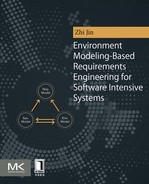Introduction
Part 1 showed that the interactive environment, the software-intensive system, and the requirements for it are independent but have three tightly integrated concerns regarding requirements engineering. Part 2 focuses on modeling the interactive environment.
Originally, ontology was a concept in philosophical terms. It describes the essence and composition of the world as philosophers see it. In computer science, ontology is mainly used for knowledge representation and provides a means for sharing knowledge.
Domain analysis refers to the activity of identifying the objects and operations of a class of similar systems in a particular problem domain. It is the process of identifying, collecting, organizing, and representing the relevant information in a domain, based on the study of existing systems and their histories of development, knowledge captured from domain experts, underlying theory, and emerging technology within the domain. The product of domain analysis is the domain model. It is the necessary foundation of the model-based approach.
System-interactive environment modeling involves building the domain model according to the following two aspects. First, as explained in Part 1, a system environment consists of the real-world interactive objects of to-be systems. Their behaviors indicate the requirements of to-be systems and will exhibit the satisfactory nature of the requirements. The interactive environment is the real problem domain of to-be systems. The more general the environment is, the bigger the coverage is of the problem domain. The general environment model can be specialized into different environment instances from different angles or by dealing with different concerns.
Second, a model-based approach can also be used in environment modeling. At the highest abstract level, the environment model should answer questions such as which kinds of interactive objects the software-intensive systems will face and which kinds of problems the systems can solve via interactions with these objects. At the middle level, the environment model should contain particular types of interactive objects in a certain application domain. It will highlight common problems and their characteristics in this application domain. At the lowest level is the environment model of the particular application.
Of course, interactive environment ontology will be different from general ontology because it is developed to allow it to be able to exhibit the capability of to-be systems. Therefore new ontological structure is needed. Traditional domain ontology represents only the static characteristics of the domain whereas the interactive environment ontology should be able to capture the dynamic or behavioral characteristics of the domain.
Part 2 focuses on the development of the interactive environment ontology, permitting it to be able to capture the capability of to-be systems. It first introduces the essence and principles of ontology and ontology-oriented domain modeling. It will detail the process of developing an interactive environment ontology. This part also proposes an extended ontological structure to represent the behavioral characteristics of the interactive environment in accordance with the need to capture the capability of to-be systems. In addition, it discusses the approach to building an interactive environment ontology from the general domain ontology on the Web. Finally, a feature model-based domain environment ontology representation is defined.
..................Content has been hidden....................
You can't read the all page of ebook, please click here login for view all page.
